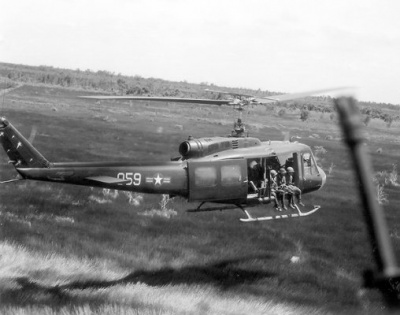Difference between revisions of "The Vietnam War"
(Created page with "=== 1955-1975 === 400px|thumbnail|left During the height of the Cold War, conflict between communist and anti-communist forces in Vietnam escalated into a...") |
|||
| Line 1: | Line 1: | ||
=== 1955-1975 === | === 1955-1975 === | ||
[[File:1955-75.jpg|400px|thumbnail|left]] | [[File:1955-75.jpg|400px|thumbnail|left]] | ||
| − | During the height of the Cold War, conflict between communist and anti-communist forces in Vietnam escalated into a significant confrontation. Although the fall of Dien Bien Phu in 1954 resulted in the Geneva Agreements, separating the North and South, the United States was not a party to the agreement. Pursuant to their policy of containment, the US continued support to South Vietnam against the Vietcong?support that rapidly increased during the war?s first decade. Following the Gulf of Tonkin Incident in 1964, the US military became directly involved in the conflict. The Vietcong?s 1968 Tet Offensive highlights the agonising effort of US forces, and under President Nixon, US military presence decreased. In 1973, the Paris Peace Agreement between the US and North Vietnam paved the way for US troop withdrawal and communist control of Saigon in 1975. | + | During the height of the Cold War, conflict between communist and anti-communist forces in Vietnam escalated into a significant confrontation. Although the fall of Dien Bien Phu in 1954 resulted in the Geneva Agreements, separating the North and South, the United States was not a party to the agreement. Pursuant to their policy of containment, the US continued support to South Vietnam against the Vietcong?support that rapidly increased during the war?s first decade. Following the Gulf of Tonkin Incident in 1964, the US military became directly involved in the conflict. The Vietcong?s 1968 Tet Offensive highlights the agonising effort of US forces, and under President [[Nixon, Richard|Nixon]], US military presence decreased. In 1973, the Paris Peace Agreement between the US and North Vietnam paved the way for US troop withdrawal and communist control of Saigon in 1975. |
[[Category:Peacebuilding and Reconciliation]] | [[Category:Peacebuilding and Reconciliation]] | ||
Latest revision as of 08:09, 1 April 2014
1955-1975[edit]
During the height of the Cold War, conflict between communist and anti-communist forces in Vietnam escalated into a significant confrontation. Although the fall of Dien Bien Phu in 1954 resulted in the Geneva Agreements, separating the North and South, the United States was not a party to the agreement. Pursuant to their policy of containment, the US continued support to South Vietnam against the Vietcong?support that rapidly increased during the war?s first decade. Following the Gulf of Tonkin Incident in 1964, the US military became directly involved in the conflict. The Vietcong?s 1968 Tet Offensive highlights the agonising effort of US forces, and under President Nixon, US military presence decreased. In 1973, the Paris Peace Agreement between the US and North Vietnam paved the way for US troop withdrawal and communist control of Saigon in 1975.
